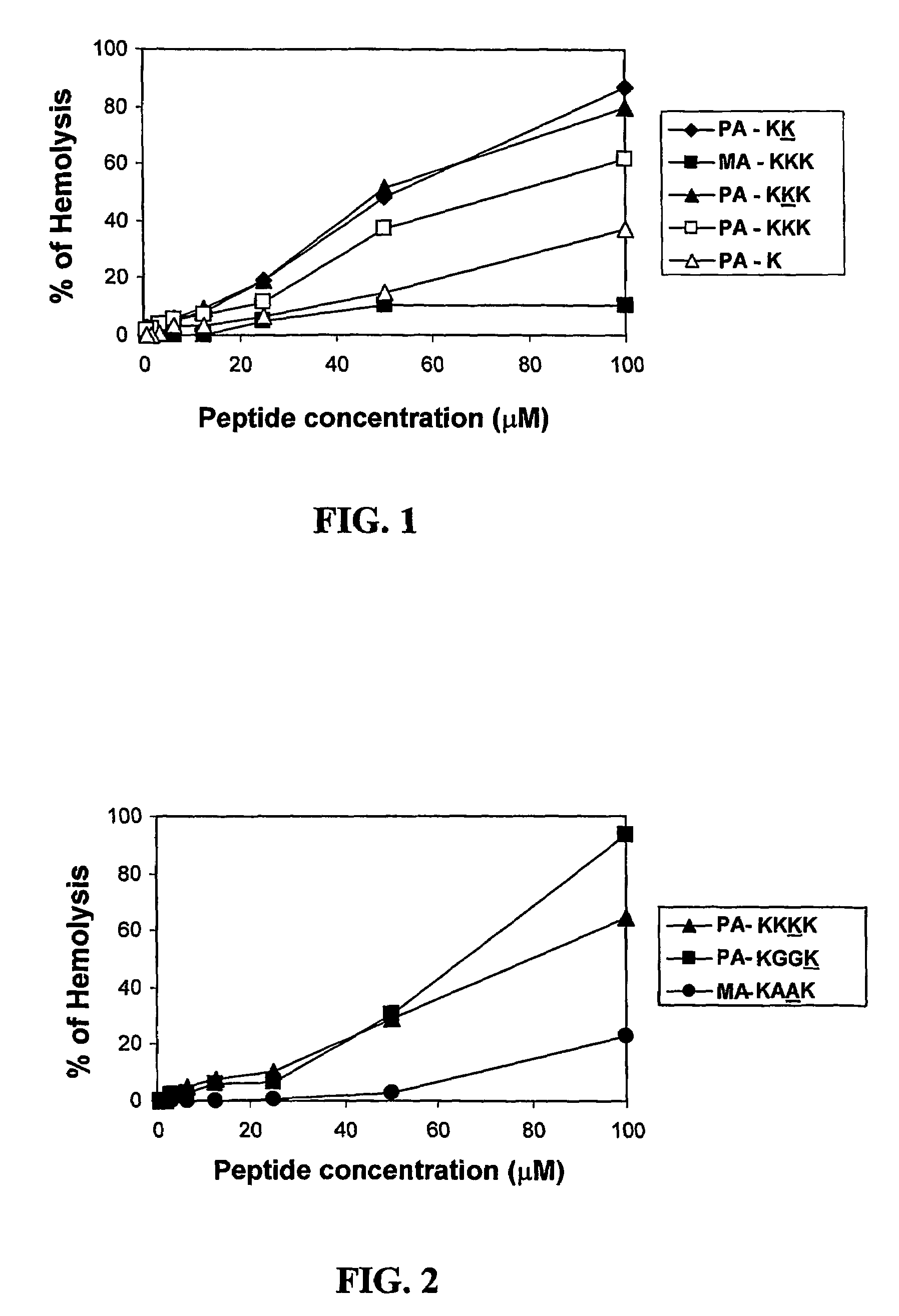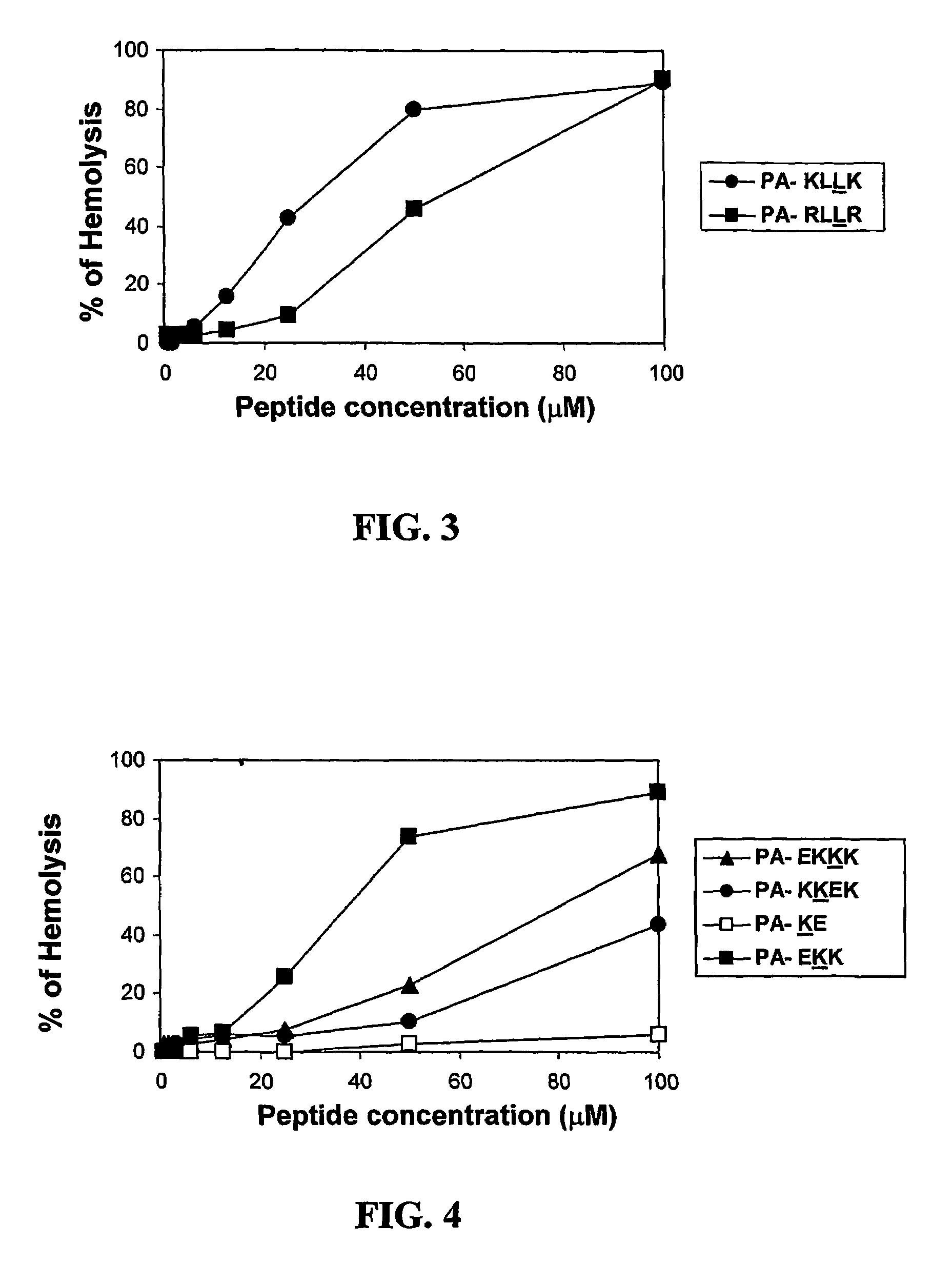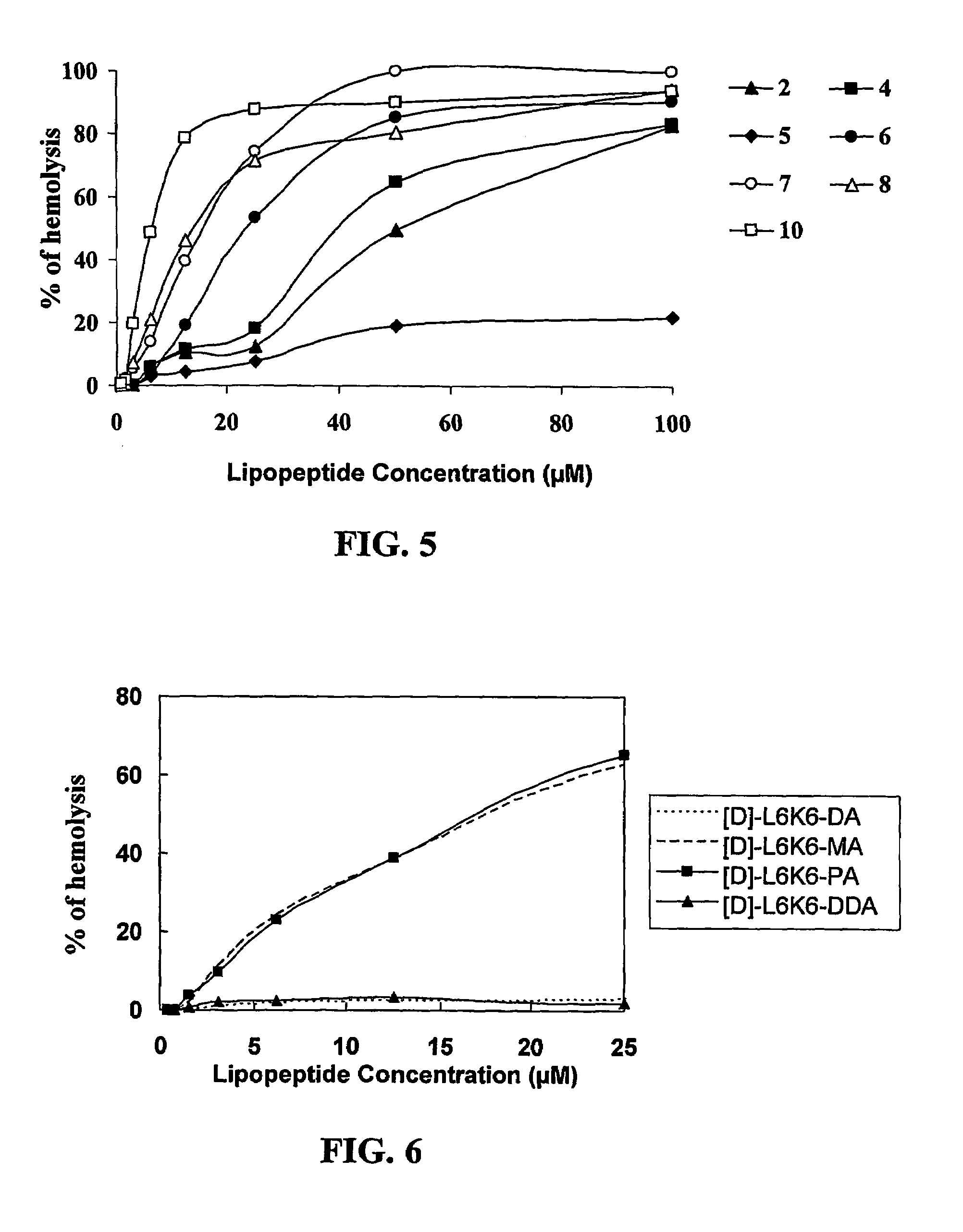Antimicrobial and anticancer lipopeptides
a lipopeptide and anticancer technology, applied in the field of lipophilic conjugates, can solve the problems of unsuccessful selection targeting of fungal cells, and achieve the effects of reducing or even eliminating the need for antibiotics, not promoting the growth of antibiotic-resistant bacteria strains, and safe and effective anti-microbial compositions
- Summary
- Abstract
- Description
- Claims
- Application Information
AI Technical Summary
Benefits of technology
Problems solved by technology
Method used
Image
Examples
example 1
Synthesis of 12-mer Linear Lipopeptides and Cyclic Peptides
[0097]The following lipopeptides were synthesized as described in the Experimental Procedures sections (ii) and (iii). Decanoic acid (DA), undecanoic (UA), dodecanoic acid (DDA), myristic (MA), or palmitic (PA) acid were conjugated to 12-mer C-amidated all L-amino acid or diastereomeric peptides to yield the lipophilic conjugates. The peptides contained a hydrophobic amino acid selected from Gly, Ala, Val, or Leu and the positively charged amino acid Lys. Each of the diastereomeric peptides contained 4-6 amino acid residues in the D-configuration. The lipopeptides will be designated hereinafter by numerals.
[0098]
1 [D]-K1,5,9,12-K4G8-MA of the sequence:(CH3—(CH2)12—CO-)-D-Lys-Gly-Gly-Gly-D-Lys-Gly-Gly-Gly-D-Lys-Gly-Gly-D-Lys-NH2 2 [D]-K1,5,9,12-K4G8-PA of the sequence:(CH3—(CH2)14—CO-)-D-Lys-Gly-Gly-Gly-D-Lys-Gly-Gly-Gly-D-Lys-Gly-Gly-D-Lys-NH2 3 K4G8-MA of the sequence:(CH3—(CH2)12—CO-)-Lys-Gly-Gly-Gly-Lys-Gly-Gly-Gly-Lys-G...
example 2
Mass Spectrometry and Retention Time of the Lipopeptides
[0103]The lipopeptides were subjected to C4 RP-HPLC to determine the effect of the fatty acid on the retention time of the lipophilic conjugates.
[0104]The amidated lipopeptides were applied on an analytical C4 column and eluted within 80 min using a linear gradient of 0 to 80% acetonitrile in water containing 0.05% TFA (v / v). The molecular weight of the lipopeptides was obtained by mass spectrometry.
[0105]
TABLE 1Sequence, molecular weight, and retention time of the lipopeptides.CalculatedRP-HPLCMolecularRetentionConjugateWeightTimeDesignationSequence(gr / mole)(minutes)[D]-L6K6L KK LL K K LL K K L -NH2146616.3[D]-L6K6-DA - 21CH3(CH2)8CO-L KK LL K K LL K K L -NH21620.329.9[D]-L6K6-DDA - 22CH3(CH2)10CO-L KK LL K K LL K K L -NH21648.332.9[D]-L6K6-MA-23CH3(CH2)12CO-L KK LL K K LL K K L -NH21676.336.1[D]-L6K6-PA- 24CH3(CH2)14CO-L KK LL K K LL K K L -NH21704.341.5Note:The D-amino acid residues are denoted by bold letters and underline....
example 3
Antibacterial Activity of the Lipopeptides at pH 7.4 and pH 5.5
[0109]The antibacterial activity of the lipopeptides was examined in sterile 96-well plates (Nunc F96 microtiter plates) in a final volume of 100 μl as follows: Aliquots (50 μl) of a suspension containing bacteria at concentration of 1×106 Colony-Forming Units (CFU) / ml in culture LB (Lauria broth) medium (pH 7.4 or pH 5.5) were added to 50 μl of water containing the lipopeptide in serial 2-fold dilutions in water. Adjustment of the pH was done by diluted solutions of HCl and NaOH. Inhibition of growth was determined by measuring the absorbance at 600 nm with a Microplate autoreader E1309 (Bio-Tek Instruments), after an incubation time of 18-20 h at 37° C. Antibacterial activities were expressed as the minimal inhibitory concentration (MIC), the concentration at which 100% inhibition of growth was observed after 18-20 h of incubation. The bacteria used were: Escherichia coli ATCC 25922, Acinetobacter baumannii ATCC 19606,...
PUM
| Property | Measurement | Unit |
|---|---|---|
| pore size | aaaaa | aaaaa |
| pore size | aaaaa | aaaaa |
| flow rate | aaaaa | aaaaa |
Abstract
Description
Claims
Application Information
 Login to View More
Login to View More - R&D
- Intellectual Property
- Life Sciences
- Materials
- Tech Scout
- Unparalleled Data Quality
- Higher Quality Content
- 60% Fewer Hallucinations
Browse by: Latest US Patents, China's latest patents, Technical Efficacy Thesaurus, Application Domain, Technology Topic, Popular Technical Reports.
© 2025 PatSnap. All rights reserved.Legal|Privacy policy|Modern Slavery Act Transparency Statement|Sitemap|About US| Contact US: help@patsnap.com



